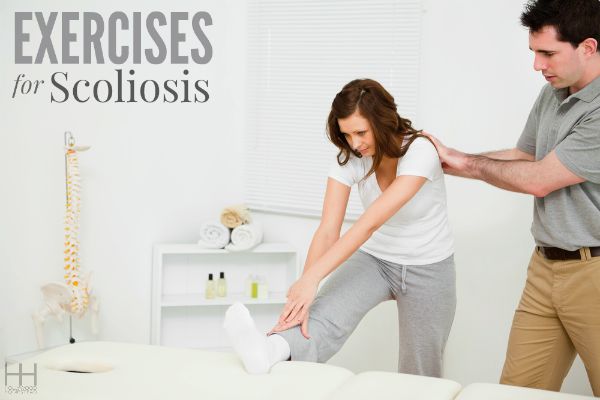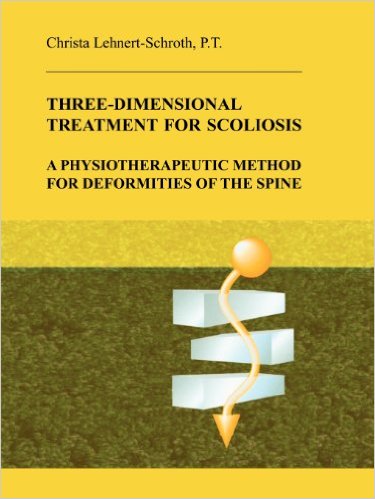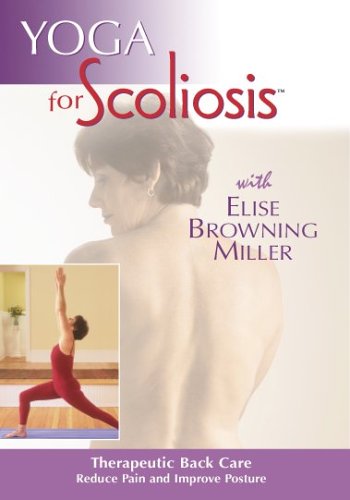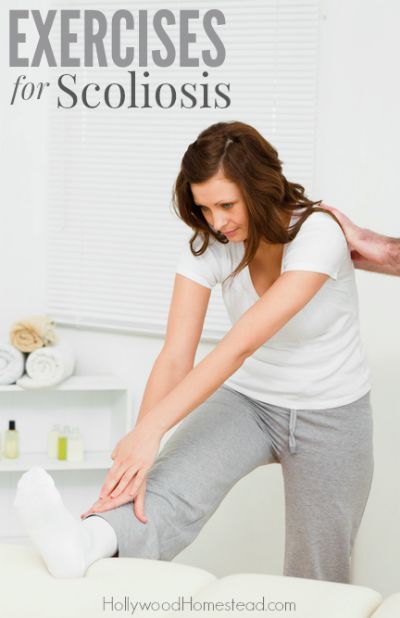
As we’ve been talking about in this series about treating scoliosis, doctors say that they don’t know what causes idiopathic scoliosis, but that is only partly true. Scoliosis occurs when the body cannot keep up with the growing process. (Source) Just like how weak muscles can cause scoliosis in degenerative scoliosis and neuromuscular scoliosis, weak muscles could play a part in idiopathic scoliosis.
Think of your body as a tower. The bones are what provide the shape, but it is the muscles and joints which hold them together. Without strong joints and muscles, your bones would collapse. By strengthening your muscles, your body will be better able to support the spine and keep it in alignment.
Caution about Scoliosis Exercises
Before you rush out and do a bunch of scoliosis exercises you find on the web or YouTube, you really need to talk to a professional. By professional, I mean someone who actually has experience working with scoliosis patients and has seen your x-rays and knows about your condition.
Each case of scoliosis is different. What will work for one patient could be DISASTROUS for another. Take the case of Sophie Barnes for example. She was recommended to do pilates for her scoliosis after giving birth. It caused her to rupture a disc which pressed on a nerve and made her left leg go numb. (Source)
Now, I’m not posting this to freak you out, but I want to make a clear distinction between the cliché “check with your doctor because I’m required to tell you that” and “No Seriously, CHECK WITH YOUR DOC first.” OK?
Goal of Scoliosis Exercises
The goal of many scoliosis exercise programs is to strengthen your spinal muscles and help pull the spine back into alignment. This is often referred to as “realignment exercises.”
Another goal of scoliosis exercises is to stop the curve from getting worse. One way this is done is by strengthening the muscles and the core, or “stabilization exercises.”
Flexibility exercises for scoliosis can help decompress the spine, and thus help bring the spine back into alignment or stop the curvature from getting worse. Another benefit of flexibility scoliosis exercises is to reduce pain, such as by reducing pressure on parts of the body.
Before starting any scoliosis exercise program, make sure you clearly understand what the goals are. This is your body we are talking about and you need to be informed! Find out what muscles are being activated, in what way, and what the desired result is. This will help you understand what results to expect and keep you motivated to do the exercises.
Controversy around Scoliosis and Exercises
Before we get into all the good exercise can do for scoliosis (or whether it can do any good at all), we’ve got to delve into the scoliosis-exercise controversy. It actually goes back to 1941 when a committee at the American Orthopaedic Association did a study on treatment methods for idiopathic scoliosis.
At the time, most clinics prescribed special exercises and/or surgery to patients with scoliosis. When the study analyzed the results, they found that:
- Surgery: 92% of patients experienced loss of correction, and 30% of patients had the same or worse curvature after surgery
- Exercise: 69% of patients were unchanged or had increased curvature by 5-15 degrees, 27% increased curvature by more than 20 degrees, and only one patient improved by more than 10 degrees
This led to the conclusion that exercise makes scoliosis worse. After the study was published, the use of exercise for scoliosis was pretty much eliminated in clinics.
It is frustrating that, because of an outdated 1941 study, exercise for scoliosis has been virtually forgotten. According to Scoliosis Journal, there are fewer than 100 articles in MedScape which look into whether exercise can help treat scoliosis.
You’ll note that the 1941 study also found that surgery either didn’t help scoliosis or made it worse, yet there have been leaps and bounds in scoliosis surgery research which have led to many breakthroughs. We can only hope that medical researchers will start giving this same attention to exercise as a viable treatment method for scoliosis. (Source 1, Source 2)
Can You Reverse Scoliosis with Exercise?
As mentioned above, there are fewer than 100 studies on exercise for scoliosis published in the MedScape database. However, some of the few studies which do exist are promising. (Source) In particular, studies do show that exercises can prevent the progression of scoliosis. If you think that exercise will reverse your scoliosis completely, I wouldn’t be as hopeful. Yes, there are dozens of testimonials on the web from people who (supposedly) fixed their spinal curvatures with exercise alone. It is worth a try — but I wouldn’t expect the miracles that some of the tout.
Both before and after scoliosis surgery (which I will write more about soon) Natalie started doing Crossfit. Crossfit isn’t something we took lightly since having a lot of weight and pressure on a back that already has stability issues is something you have to be careful with. We were lucky to find a class for teens in Los Angeles with a teacher that has a teen with scoliosis and was willing to modify the exercises for Natalie so that she could not only do them safely but so that they could help strengthen the weaker sections of her back.
The best part is that Natalie loved these classes which I think is key for any of us to stick to any exercise regimen. She went weekly right up until her surgery and as soon as the doctor gave her the all clear after surgery she went back, very carefully.
One of the things we did for Natalie’s scoliosis was the CLEAR Institute (which I wrote about here). We attended a 3-week “bootcamp” and then exercises 5x/day for 3 months. Her curve decreased from 47 degrees to 34 degrees during this period! But then she went to her grandmother’s house in Argentina for 3 months. She told me she was doing her exercises, but she later admitted she was only doing them once per day (and who knows if she was doing them that much). By the time she came back, her curve had progressed to 53 degrees. So I can’t testify to whether the scoliosis exercises would have worked in the long run.
The one big benefit we did get from the scoliosis exercises was this: they greatly helped her recover faster from scoliosis surgery. Natalie had abs of steel from all the CrossFit she was doing, which helped her lift herself out of bed faster. The nurses and doctors at the hospital were honestly amazed at how quickly she recovered. Being able to use her (very strong) abdominal muscles when her back muscles were really out of commission along with a nutritious diet with an emphasis on bone building foods like gelatin were both very key to her recovery.
Types of Scoliosis Exercises
Schroth Method: This is one of the best-known exercise programs for scoliosis, and it is one of the few methods which has actually been tested and shown to have positive results. It was developed in the 1920s and it is now popular as a scoliosis treatment in many European countries. Schroth use exercises to correct imbalances in the spine, stabilize the spine, restore flexibility to stiff areas of the body, improve cardio-pulmonary function, and more.
You can learn more at the Schroth website or read the book Three-Dimensional Treatment for Scoliosis: A Physiotherapeutic Method for Deformities of the Spine. You can find the book here.
SEAS Method: SEAS stands for Scientific Exercises Approach to Scoliosis. The main goal of SEAS is to reverse what is known as the “Stokes vicious cycle” where an asymmetrical load is created on the body. This load causes pressure on the spine, making the scoliosis get worse. The SEAS exercises focus on daily movements and activity so the spine becomes more stable and is self-corrected by activities in daily life. Scoliosis Journal has a good article about SEAS here.
Egoscue Method: The Egoscue Method was created by Pete Egoscue in the 1970s and now they have more than 25 clinics worldwide. They are vehemently opposed to surgery and instead prescribe a set of exercises designed to help the body get back into alignment. We found out about the Egoscue Method when Natalie was already very advanced in her scoliosis and had decided to go into surgery. If you are still at an earlier stage of scoliosis, Egoscue may be worth considering. You can find a book on Egoscue method here.
CLEAR Institute: The CLEAR Institute is a program which educates and certifies doctors and chiropractors in how to treat scoliosis with re-alignment exercises. We tried the CLEAR Institute and did initially see some results with it. You can read about our experience with CLEAR here.
Yoga for Scoliosis: Yoga focuses on strengthening the body and improving flexibility – two things which are very important for scoliosis. Before you go signing up to just any yoga class for scoliosis, please make sure the yoga instructor has experience! You can’t just jump into exercises for scoliosis and hope that they will help. You could end up making things a lot worse.
We were lucky enough to find a great yoga instructor near our home in LA. We hired Tulsi, the owner of Yoga Daya in West Los Angeles for 1 private session at home with Natalie, and then Nat was able to join in her group classes. Natalie really liked attending her classes as it helped tremendously with the common back pain associated with having a spinal curve. Read more about our experience with yoga for scoliosis here.
I also really like this DVD course about yoga for scoliosis. Elise Browning Miller is a leading expert in scoliosis and this is really one of the best videos you can get (though it is still no substitute for in-person yoga classes with a certified professional!).
How to Get Started with Scoliosis Exercises
If you do a Google search for “scoliosis exercises,” you will find all sorts of articles and videos. Do you really want to trust your spine with some random person from YouTube?
REMINDER: DON’T DO ANY SCOLIOSIS EXERCISES UNTIL YOU’VE TALKED TO YOUR DOCTOR!
I recommend looking into the various types of methods, and then seeing if there are any certified/experienced practitioners in your area. The Schroth and CLEAR websites have lists of certified practitioners, but you could easily accomplish this with a search too. Once you do get an approved exercise program for your scoliosis, make sure to do it! You won’t get results unless you stick with it!
Want to learn more about managing scoliosis? Download my eBook for comprehensive information on causes of scoliosis and the best treatment options. You can buy it here.
Have you tried exercises for scoliosis? I’d love to hear about your experiences!
Latest posts by Sylvie McCracken (see all)
- Treating H. Pylori (Part 3): What H. Pylori Does to the Body - August 8, 2022
- Treating H. Pylori (Part 2): How H. Pylori is Contracted - August 3, 2022
- Understanding Beef Labels: Organic, Pastured, Grass-Fed & Grain-Finished - July 25, 2022



